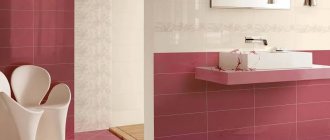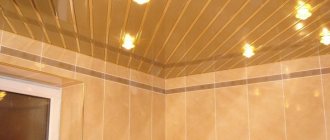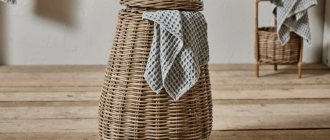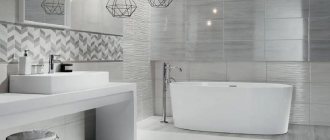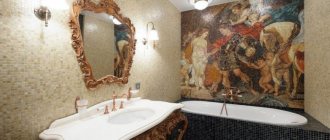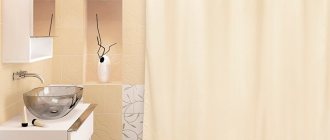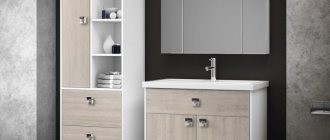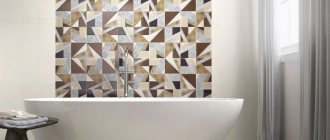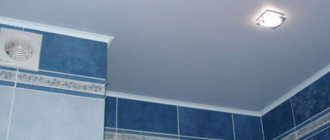The traditional curtain made of water-repellent material for enclosing the shower area no longer meets consumer requirements: it is not aesthetically pleasing or durable enough.
It was replaced by opening or sliding curtains made of glass or plastic. A shower screen is an important element of bathroom zoning. It will not only separate the bathing area, but also protect furniture, floors and walls from water and splashes.
A functional and beautiful bath screen, assembled with your own hands from simple materials, can become a source of personal pride and decoration for a bathroom or shower room.
Advantages of a homemade screen in the bathroom
Protective curtains are available in every construction supermarket. They differ in size, material and design features: you can choose a finished product to suit every taste and budget. At the same time, it is not difficult to build a good curtain with your own hands.
And this option has its undeniable advantages:
- Originality. You can make a design of a non-standard configuration that will harmoniously fit into the interior of the bathroom.
- Compliance with all the requirements and wishes of the owner. For example, you can accurately maintain the required dimensions without losing even 1 cm of usable space.
- Ergonomics. If there is a shortage of space, using a non-standard partition will help you adjust the layout: allocate less space for the shower area and gain space for household appliances.
With the help of modern materials with a wide palette of colors and textures, you can realize any idea. Glass or plastic panels can be embossed or smooth, plain, patterned or transparent. They can cover the opening completely or partially, be stationary or fold and open in different directions.
› Glass sliding curtains for bathroom
The sliding curtain can be installed across the entire width of the bathtub and mounted with fastening on the walls on both sides. Also, such a curtain can be angular and completely cover the entire bath.
Click on the image to enlarge it
05
06
07
08
Did you like the curtain from the photo? Send us a request and indicate the photo number:
Varieties of design
Protective screens for showers and bathtubs are divided into frameless, framed and combined.
Depending on the method of connecting the panels to each other, partitions are:
- Stationary. Such curtains are fixed motionless and protect only that part of the bathtub where the shower stand is installed.
- Foldable. They consist of narrow sections that fold like an accordion. A convenient option for a corner or curved bathtub.
- Swing. The design is similar to doors; they consist of 1-2 leaves suspended on hinges. An inconvenient option for cramped bathrooms - it requires a lot of space to open freely.
- Sliding. The blades move along the guides, opening or closing the opening. For better sliding, roller systems are used. Versatile and compact option. Suitable for limited space.
Frame screens
This design involves the presence of a framing profile made of aluminum or plastic. For panels, 4 mm glass or plastic is used. Such protective screens can consist of one or several sections.
Some of the panels can be fixed motionless, making them a stationary partition, while the remaining ones will fold or move on rollers along the guides.
Frame screens are durable and reliable. They are sealed and well protect surrounding objects from splashes and streams of water. Rigid construction is the safest solution for families with small children.
The main disadvantage of a screen on a frame is its massiveness. It can only be installed in a spacious room: in a cramped space, such a design will look too bulky, visually reducing the space, which is already small.
Using frame technology, you can also make sliding screens that hide pipes and connections. An original screen for the bathtub, made with your own hands from the same materials as the shower curtain, will stylistically support the design of the bathroom. In addition to aesthetics, such a screen also performs a practical function, for example, it adds stability to an acrylic bathtub.
Frameless structures
They are most often made of thick tempered glass (6-8 mm). Sections can be installed permanently, moved away or folded. Fixed load-bearing elements are made from thicker canvases, movable ones from light and thin ones.
The absence of a frame makes such structures smaller in size and visually light. They look great in small spaces. Folding screens are especially convenient: they are easily assembled like an accordion against the wall and do not clutter up the approach to the bathroom.
The main disadvantage of this design is poor tightness: water easily seeps into the cracks between the panels. But if you use the shower carefully and do not turn on high pressure, this will not create problems.
Combined
Such screens combine the design features of the first 2 options. For example, the stationary part is framed by a profile, and the movable part is a glass or plastic panel with hinges or hinges.
What to consider when choosing?
Before purchasing the product, pay attention to the following features:
- Number of doors . The choice depends on the length of the bath.
- Sash dimensions . They should be the same. The standard height is 140 cm, but parameters may vary depending on the depth of the bowl and the height of the ceilings.
- Quality of material . It is better to choose glass products with a thickness of at least 6 mm. The material must be hardened and impact resistant. The polycarbonate partition can have a thickness of 4 mm.
- Quality of fittings . It is necessary to pay attention not only to the main material, but also to the fasteners. They should all be strong and water-repellent.
- Degree of transparency . It is advisable to install tinted partitions in a combined bathroom. Transparent screens will not visually divide the room into sections.
- Attached to the walls or sides of the bathtub . Places of fixation play an important role. Consider in advance the possibility of attaching the partition.
Materials used
To install the screen you will need:
- guide profile (aluminum can withstand heavy loads and will last longer);
- sheets of plastic or glass cut to size;
- silicone sealant;
- accessories: hinges, screws, etc.
Transparent materials are the most popular: they are economical and do not overload the interior. The most expensive option is tempered glass with a decorative pattern.
Plastic or polycarbonate
Plastic attracts with its variety of colors, decor and low price. It is practical, easier to work with at home: it is easy to cut, does not prick, etc. The main disadvantage of this material is that it will not last as long as glass or polycarbonate, it is easily scratched and quickly loses its appearance.
When choosing this material, keep in mind that plaque and dirt appear on it quickly. With insufficient care, the appearance becomes untidy and the surface becomes cloudy. Fungus or mold may appear.
Polycarbonate is a durable, versatile polymer. It is lightweight and impact-resistant, therefore safe and easy to install.
It is more practical in operation than plastic; it can easily withstand high humidity and temperature changes, which is why it is often used for making cabinets and screens. In appearance and durability, things made of polycarbonate are no worse than glass.
Glass
This material is not as impact-resistant as polycarbonate, although high-quality tempered glass comes close in this characteristic. The safest and most durable is triplex. The risk of injury when using it is minimal: if such glass breaks, it will not crumble into small and sharp fragments.
The remaining performance characteristics of this material are higher than those of plastic. Mold does not form on it; its surface can be easily cleaned with a special product and a cloth or paper napkin.
A transparent glass screen is a win-win option, suitable for any style of bath design.
Evaluation of plastic curtains
If we think logically, then bath curtains, despite their popularity, have both advantages and disadvantages. They will be discussed in more detail below.
pros
The advantages of plastic sliding curtains for the bathroom include:
- light weight and accessibility. Therefore, it is easy to install such structures in the bathroom;
- ease of care. If dirt has accumulated on the surface or smudges have appeared, it is enough to clean the surface with a sponge soaked in water and detergent. It is safe to use such structures;
- non-toxic. Even if they collapse, they will not crumble into small particles;
- variety - you can choose a curtain to suit any bathroom;
- gives the room aesthetics and elegance;
- thanks to the sliding parts and reliable fixation at the base, the bathroom will be reliably protected from drops of water and steam;
- budget cost. You can change the design of your bathroom without breaking the bank;
- static. While taking a shower, the bath curtain will not stick to your body. Therefore, you will not experience discomfort.
Minuses
Despite their popularity, sliding bath curtains also have a number of disadvantages.
Namely:
- short service life. Of course, if you compare them with classic fabric types. If fabric curtains need to be changed at intervals of 2 years, then plastic structures should be replaced every 5-8 years;
- high density of plastic. This leads to the fact that after installation it is necessary to install additional lighting in the bathroom;
- loss of brightness during operation. A cloudy yellowish tint, water and soap stains, etc. may appear on the surface. To clean curtains you need to use special products.
- the appearance of microcracks if the structure is handled carelessly;
How to choose which screen to make
The design of the screen, its shape and color can significantly improve or, conversely, ruin the appearance and ergonomics of your bathtub.
Pay careful attention to the choice of design and color:
- a room decorated in dark colors is visually smaller than a light one;
- matte partitions look more massive than transparent ones;
- bright designs and large patterns quickly become boring and difficult to combine with the rest of the decoration.
To install a screen on a bathtub, you do not need the skills of a professional finisher or plumber. If you doubt your abilities, give up glass. It is easier to work with plastic: it does not require special tools for processing (you can cut the canvas with a stationery knife) and will not crack at the slightest blow.
Conclusion
A glass bath screen, sliding or stationary, is the best option from both an aesthetic and practical point of view. However, you should consider the budget and design of the room. If you plan to do the work yourself, order glass production or contact a specialist so that he can give the material the required dimensions. Plastic is much easier to work with.
A partition made of such dense materials reliably protects the room from splashes of water. You can choose a product of any design, structure, shape, color and material. A wide range of products allows you to purchase a ready-made screen or all the necessary elements for self-production.
DIY options
At home, it is easier to use polycarbonate or plastic to equip the shower space: they are easier to cut to size, they are lighter and will not break if dropped or hit.
Polycarbonate screen on frame
Prepare material and tools:
- sheet of plastic;
- aluminum profile;
- drill with a set of drills, incl. on concrete;
- hacksaw for cutting profiles;
- screwdriver;
- large stationery knife;
- silicone sealant;
- marker for marking;
- tape measure and building level.
The first stage is the production of a frame that defines the shape. The load-bearing parts in this design will be the vertical side rails. Horizontal profiles (top and bottom) will become guides for the sliding panels. When assembled, a bathtub with such a screen will resemble a shower box.
Algorithm of actions:
- We measure the required length and cut out the profile.
- We mark on the wall the location of the vertical load-bearing planks, drill holes and use self-tapping screws and dowels to fasten the profile to the wall.
- We install a lower guide profile along the side of the bathroom. Carefully fill the gaps with sealant.
- While the sealant dries, cut out the polycarbonate sheet.
- We insert the part cut to size into the installed guides.
- We mount the top guide on top of the panels.
- We attach a small handle in a convenient place.
Glass partition without frame
A glass partition looks good, fits into any design, is easy to maintain and lasts a long time. For its manufacture, both simple transparent and tinted, milky white or patterned glass are used.
Working with glass is more difficult than working with plastic. It is advisable to have some experience and relevant skills. If you choose this option, order cutting of the glass sheet in the workshop. Carefully cutting to size and processing the edges of glass is only possible using special equipment. For safety, be sure to round all corners.
The assembly algorithm does not differ from the installation of a frame partition. To work, you will need prepared panels, a profile and tools (drill, hacksaw, level and screwdriver). A stationary frameless screen is attached to one of the sidewalls to the wall, and along the lower side to the bathroom. Don't forget to seal the seams with sealant.
You can install a folding screen. To do this, hinges are installed on the side support rails and the glass sheet is already hung on them.
Combined plastic design
It combines the design features of the first 2 types. Most often it consists of a stationary frame part and a movable frameless sash.
Rules for choosing a sliding system
If you don’t want to make a mistake when choosing a bath curtain, follow these recommendations:
- Select size and compatibility with your bathroom. Each manufacturer has different models that differ in shape, volume and design. If you need a custom bathroom screen, you can order it from a specific brand. True, the price will be much higher;
- select fittings and type of roller mechanism. Make sure that all parts are strong and reliable;
- inspect the sample provided. It is important that it opens and closes silently. Better - a bath curtain with copper wheels;
- do not buy a curtain that is produced by an unverified manufacturer. Otherwise, you risk purchasing a low-quality curtain that will need to be replaced quickly. Choose products from well-known brands that provide a guarantee on their products;
- do not buy screens that emit a pungent chemical smell. This indicates that the manufacturer has made poor savings on the purification of raw materials;
- choose models with stands that are adjustable. This will save you from having to adjust the design if the bathroom has non-standard dimensions. If the vertical angle has a slope, the slats may become warped;
- Choose models that are easy to clean for hygiene and aesthetics in the bathroom. As soon as you take a shower, immediately wipe the surface with a napkin. Eliminate residual water drops that can cause streaks, mold and leaks. Don't forget to wipe down the slats to ensure cleanliness.
Additional installation tips
The service life of the screen largely depends on the assembly. Accuracy of execution, accuracy of measurements and technical nuances are important here.
Before installation, think through all the details:
- Do you need a gap between the top edge and the ceiling to ventilate your shower stall.
- Is there a need to install an additional lamp in the water treatment area?
Pay special attention to the selection of metal fittings: rollers, hinges, fasteners, rubber bands, etc. Products of poor quality are not able to ensure trouble-free sliding or smooth opening of the sashes.
"Classics of the genre"
Classic sliding screen for the bathroom
Most often, bathroom screens are made in a classic form, they have a frame on which the canvas is stretched. The structure may also have doors. At the same time, the number of sashes is not limited; it all depends on the specific model and size of the leaf; two- and three-leaf designs stand out among the most popular.
Today there are several types of structures, namely:
- Pivot - consists of elements that swing open, like doors;
- Folding ones have a huge advantage, as they are very compact, which is especially important in small bathrooms;
- Sliding shower screens are also very compact; such a shower screen has a frame along which the doors move on a special slide. It is the frame of this type of screen that is the main disadvantage, because it can create some inconvenience when moving and storing.
How to care for a homemade screen
To clean plastic, choose non-aggressive means: caustic chemicals and abrasive particles will damage the plastic surface, it will become scratched and cloudy. Polycarbonate sashes must be wiped dry after each shower - dried drops of water leave whitish marks on it that are difficult to remove.
A glass screen requires less maintenance. To clean it, use the same products as for the mirror.
Don’t forget about the hinges, rollers and rubber seals: they need to be cleaned and lubricated periodically.
› Hydrophobic (water-repellent) coating
A hydrophobic coating (anti-drip) is used to impart water-repellent properties to the glass of the shower enclosure. Water repellents make the glass surface non-wettable for water and liquid dirt. This property prevents water from remaining on the glass. Thus, the hydrophobic coating eliminates white deposits and stains, as well as the formation of condensation on the surface of the glass, and greatly simplifies the maintenance of the surface of the shower enclosure. Cost of coating: 500 rub./m2
Advantages of hydrophobic coating:
- • Stable hydrophobization of the glass surface;
- • Coating resistant to mechanical stress;
- • Easy glass cleaning;
- • There are no streaks or white deposits on the glass;
- • Reduces the amount of household chemicals used.
Photos of homemade bath structures
Your homemade curtain will look no worse than an expensive purchased booth if you follow 3 basic rules:
- correct design;
- careful installation;
- careful operation and regular maintenance.
If you don’t yet know how to decorate the shower area of your bathroom, photographs of successful homemade projects will help you make a decision.

